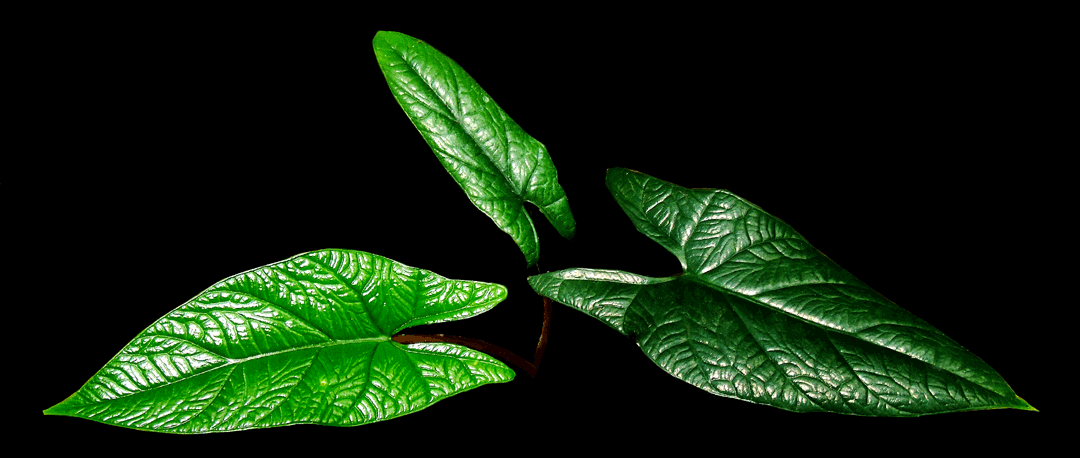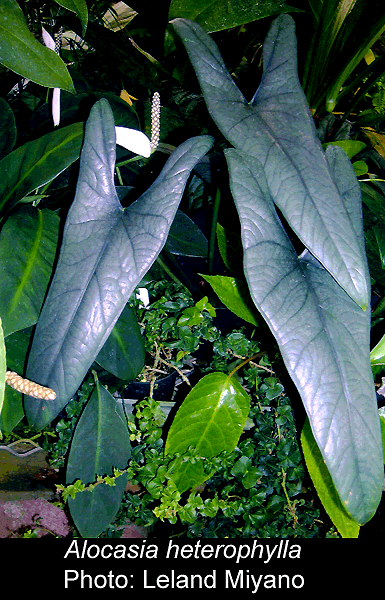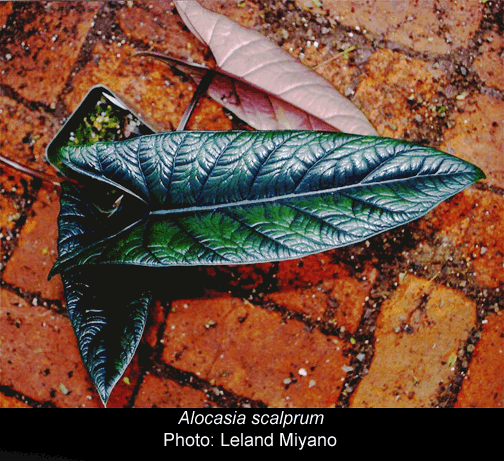![]()
Aroids and other genera in the Collection
Take the Tour Now?
Orchids
The
Exotic Rainforest
Plants in
the Exotic Rainforest Collection
Images on this website are copyright protected. Contact
us before attempting to reuse.
New:
Understanding, pronouncing and using
Botanical terminology, a Glossary
Alocasia 'Samar Lance'

Alocasia scalprum
A. Hay
Alocasia 'Samar Lance'
Sometimes confused with Alocasia heterophylla (C. Presl) Merr.
Alocasia scalprum was first introduced to us by avid Hawaiian plant collector Leland Miyano when he forwarded a photograph of his specimen and asked if I knew the correct species name. I did not. But with the help of botanists Peter Boyce and Lord Alistair Hay (Alistair identified the plant to science in 1999), via the International Aroid Society aroid discussion group Aroid l, Leland and I soon had an identification which turned out to be Alocasia (al-o-CAH-see-ah) scalprum. Alocasia species are known to be highly variable and not every leaf of every specimen will always appear the same.
However, there is a very similar but
scientifically different species known as Alocasia
heterophylla (C. Presl) Merr. A.
 heterophylla was first described
to science in 1908. Alistair explains the differences in the two
species, Alocasia
scalprum has very reduced posterior lobes to the leaf. Alocasia heterophylla also has rather distinctively conspicuous sub-marginal
veins. The posterior
lobes are found at the top of the blade whilr sub-marginal veins refers
to the teretiary or minor leaf veins observed on the the leaf blade.
Alocasia
heterophylla has been collected in Quzon Province in the
Philippines and you can see a photo of the blade on TROPICOS here:
http://www.tropicos.org/name/210021
heterophylla was first described
to science in 1908. Alistair explains the differences in the two
species, Alocasia
scalprum has very reduced posterior lobes to the leaf. Alocasia heterophylla also has rather distinctively conspicuous sub-marginal
veins. The posterior
lobes are found at the top of the blade whilr sub-marginal veins refers
to the teretiary or minor leaf veins observed on the the leaf blade.
Alocasia
heterophylla has been collected in Quzon Province in the
Philippines and you can see a photo of the blade on TROPICOS here:
http://www.tropicos.org/name/210021
 Aroid expert Julius Boos
provided this explanation of the structure of an inflorescence,
"In aroids, there are two types of
infloresence. One with a bisexual spadix, where the male and
female flowers occur in groups along the entire length of the spadix
which is attended by a simple, leaf-like and sometimes attractively
colored spathe. Examples of these species are the genera Anthurium,
Monstera and Spathiphyllum. There other groups of aroid genera
which produce a bisexual infloresence. In those, the male,
female and sterile flowers are separated into distinct zones. The
female flowers are the lowest on the spadix. In most cases the
sterile flowers are above the female zone on the spadix with the
male flowers at the top. In some species there is another sterile
zone above the male zone. In this group the spathe is generally
divided into two portions, the limb (upper blade) and a convolute
lower tube or chamber which surrounds the zone of female flowers.
Examples of this group are Alocasia, Amorphophallus and
Philodendron."
Aroid expert Julius Boos
provided this explanation of the structure of an inflorescence,
"In aroids, there are two types of
infloresence. One with a bisexual spadix, where the male and
female flowers occur in groups along the entire length of the spadix
which is attended by a simple, leaf-like and sometimes attractively
colored spathe. Examples of these species are the genera Anthurium,
Monstera and Spathiphyllum. There other groups of aroid genera
which produce a bisexual infloresence. In those, the male,
female and sterile flowers are separated into distinct zones. The
female flowers are the lowest on the spadix. In most cases the
sterile flowers are above the female zone on the spadix with the
male flowers at the top. In some species there is another sterile
zone above the male zone. In this group the spathe is generally
divided into two portions, the limb (upper blade) and a convolute
lower tube or chamber which surrounds the zone of female flowers.
Examples of this group are Alocasia, Amorphophallus and
Philodendron." Alocasia scalprum is endemic to (exclusively found in) the Philippines, but is said to be known only from Samar island. As a result of the limited habitat, A. scalprum is now quite rare in private collections. Alistair included this note in his published description of A. scalprum, "This species is apparently quite well known in cultivation in the Philippines, but not represented by any wild-collected herbarium material. Burnett (1984) notes that what is considered in the horticultural community to be one species is highly variable and he lists four selected varieties all said to have originated from the island of Samar. The only material I have seen in flower, which forms the holotype, seems exactly to match the cultivar known as `Samar Lance’. Although it seems probable that the other forms mentioned and illustrated in Burnett (loc. cit.) are conspecific with A. scalprum, this remains to be verified."
Aroid Pollination!
As
it occurs in nature and by any horticulturist